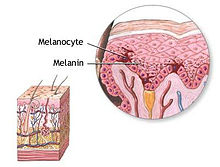| Piebaldism | |
|---|---|
| Other names | PBT[1] |
 | |
| This condition affects melanocyte development | |
| Specialty | Dermatology |
Piebaldism refers to the absence of mature melanin-forming cells (melanocytes) in certain areas of the skin and hair. It is a rare autosomal dominant disorder of melanocyte development.[2]: 867 Common characteristics include a congenital white forelock, scattered normal pigmented and hypopigmented macules and a triangular shaped depigmented patch on the forehead. There is nevertheless great variation in the degree and pattern of presentation, even within affected families. In some cases, piebaldism occurs together with severe developmental problems, as in Waardenburg syndrome and Hirschsprung's disease.
Piebaldism has been documented to occur in all races, and is found in nearly every species of mammal. The condition is very common in mice, rabbits, dogs, sheep, deer, cattle and horses—where selective breeding has increased the incidence of the mutation—but occurs among chimpanzees and other primates only as rarely as among humans. Piebaldism is unrelated to conditions such as vitiligo or poliosis.
Although "partial albinism" is a synonym for piebaldism,[3] it is a fundamentally different condition from true albinism. The vision problems associated with albinism are not usually present as eye pigmentation is normal. Piebaldism differs from albinism in that the affected cells maintain the ability to produce pigment but have that specific function turned off. In albinism the cells lack the ability to produce pigment altogether. Human piebaldism has been observed to be associated with a very wide range and varying degrees of endocrine disorders, and is occasionally found together with heterochromia of the irises, congenital deafness, or incomplete gastrointestinal tract development, possibly all with the common cause of premature cutting off of human fetal growth hormone during gestation. Piebaldism is a kind of neurocristopathy, involving defects of various neural crest cell lineages that include melanocytes, but also involving many other tissues derived from the neural crest. Oncogenic factors, including mistranscription, are hypothesized to be related to the degree of phenotypic variation among affected individuals.
- ^ "Piebaldism | Genetic and Rare Diseases Information Center (GARD) – an NCATS Program". rarediseases.info.nih.gov. Archived from the original on 16 April 2019. Retrieved 16 April 2019.
- ^ James, William; Berger, Timothy; Elston, Dirk (2005). Andrews' Diseases of the Skin: Clinical Dermatology. (10th ed.). Saunders. ISBN 0-7216-2921-0.
- ^ "Partial Albinism". Retrieved Jan 1, 2024.